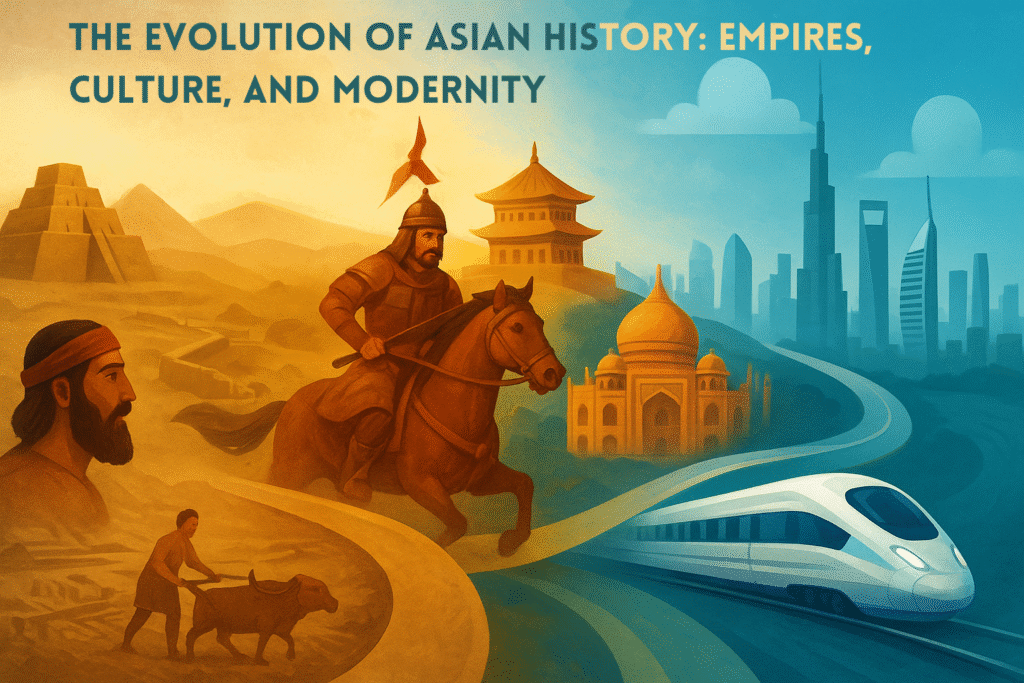Asia is huge. Like really huge. It’s the biggest continent on earth, and its history is just as massive. If you look back thousands of years, this land has seen the rise of powerful empires, the birth of big religions, amazing inventions, and also struggles that shaped the modern world. Honestly, to talk about all of it in one blog is kind of impossible, but let’s just take a walk through some of the main parts.
The Very Beginning
When people talk about the “first civilizations,” Asia is always there. Mesopotamia, in present-day Iraq, is often called the cradle of civilization. People there invented writing, laws, and built early cities. Meanwhile, in South Asia, the Indus Valley Civilization had big planned cities, proper drainage, and even trade networks — super advanced for its time.
Over in China, dynasties like the Shang and Zhou popped up and gave us early Chinese culture, traditions, and philosophy. So yeah, Asia wasn’t just surviving back then. It was basically inventing the idea of civilization.
Empires, Empires Everywhere
Fast forward a few centuries, Asia became home to some of the biggest empires the world has ever seen. The Persians built roads that connected three continents. In India, the Maurya and Gupta Empires gave the world not only political unity but also Buddhism, math concepts, and great literature.
China kept rising with dynasties like the Han and Tang, who gave the world paper, printing, and even gunpowder. And then came the Mongols. Genghis Khan basically created the largest land empire in history, making trade on the Silk Road safer (though… also lots of battles and destruction).
On the western side, the Ottoman Empire stood strong for centuries, controlling trade and acting like a bridge between Europe and Asia.
Culture, Not Just Wars
One mistake people make when thinking about Asian history is to only focus on kings and battles. But Asia was also the heart of culture and ideas. Religions like Hinduism, Buddhism, Islam, and philosophies like Confucianism started here and spread across the world. That’s billions of people influenced!
The Silk Road was more than just silk and spices. It carried ideas, art, inventions, and even diseases. Imagine Chinese porcelain ending up in Rome or Indian numbers (yep, what we call Arabic numerals actually came from India) being used in Europe.
And when it comes to beauty — Asia gave us Persian poetry, Indian temples, Chinese paintings, Japanese samurai traditions, and so much more.
Colonization and Hard Times
From the 16th century, things started to change. European powers like the British, French, Dutch, and Portuguese came to Asia. They built railways and factories but mostly for their own profit. Colonization brought development in some ways but also poverty and cultural loss for local people.
But Asians didn’t just accept it. Leaders like Mahatma Gandhi in India inspired whole nations to fight back. Slowly but surely, independence movements spread across the continent, and by the mid-20th century, most Asian countries had thrown off colonial rule.
Asia Today
The 20th century wasn’t easy. World War II hit Asia hard — China was invaded, Japan was bombed, and countries across the Pacific suffered. But from the destruction, nations rebuilt.
Japan became a tech powerhouse. China went through revolutions and became one of the strongest economies today. India became the world’s largest democracy. South Korea, Singapore, and others modernized at lightning speed. And let’s not forget the Middle East, where oil changed global politics forever.
Wrapping It Up
The history of Asia is like a rollercoaster. Ancient cities, giant empires, big religions, colonial struggles, and then the modern rise. It’s not always a happy story, but it’s a powerful one.
Asia’s past isn’t just about Asia — it’s about the whole world. The inventions, the ideas, the cultures… they all shaped the way we live today. And looking at how fast Asia is growing right now, it’s pretty clear the continent’s story is far from over.


